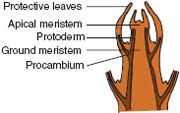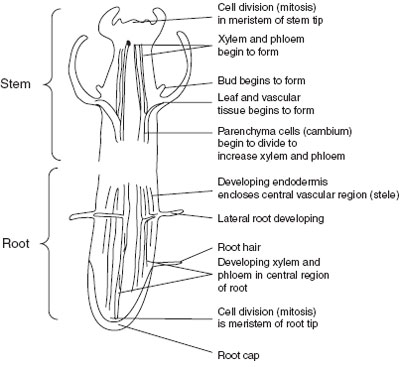 |
Figure 6.6 The tip of a
dicotyledonous stem showing
the four meristematic areas |
Growth of stems is initiated in the
apical, or terminal,
bud at the end of
the stem (the apex). Deep inside the apical bud is a tiny mass of small,
delicate jelly-like cells, each with a conspicuous nucleus but no cell
vacuole. This mass is the
apical meristem (see Figure 6.6). Here, cells
divide frequently to produce four kinds of meristematic tissues. The first,
at the very tip, continues as meristem cells. The second (protoderm)
near the outside develops into the epidermis. The third (procambium)
becomes the vascular bundles. The fourth (ground meristem) turns into
the parenchyma, collenchyma, and sclerenchyma tissues of the cortex
and pith. In addition to its role in tissue formation, the apical meristem
also gives rise to small leaves (bud scales) that collectively protect the
meristem. These scales and the meristem together form the
bud. It should be noted that any damage to the sensitive meristem
region by aphids, fungi, bacteria or herbicides would result in distorted
growth. A fairly common example of such a distortion is
fasciation,
a condition that resembles a number of stems fused together. Buds
located lower down the stem in the angle of the leaf (the axil) are called
axillary buds; they contain a
lateral meristem and often give rise to
side branches.
In some plant families, e.g. the Graminae, the meristem remains at
the base of the leaves, which are therefore protected against some
herbicides, e.g. 2,4-D. This also means that grasses
re-grow from their base after animals have grazed them. The new blades
of grass grow from meristems between the old leaf and the stem. This
means grasses can be
mown which enables us to create lawns. The
process of cutting back the grass also leads to it sending up several
shoots instead of just one. This process of
tillering helps thicken up
the turf sward to make it such a useful surface for sport, as well as
decoration. Mowing kills the dicotyledonous plants that have their stems
cut off at the base and lose their meristems. However, many species are
successful lawn weeds by growing in
prostrate form; the foreshortened
stem (very short internodes) creates a
rosette of leaves that helps to
conserve water, shades out surrounding plants and the growing point
stays below the cutting height of the mower.
 |
Figure 6.7 Diagram of stem and root showing areas of
differentiation. |
Elongation of the plant stem takes place in two stages. Firstly, cell
division, described above, contributes a little. The second phase is cell
expansion, which occurs at the base of the meristem. Here, the tiny
unspecialized mer-istem cells begin to take in water and nutrients to
form a cell vacuole. As a result, each cell elongates, and the stem rapidly
grows. In the expansion zone, other developments begin to occur.
Cell differentiation
Most importantly, the cells begin to create their cell walls, and the
connections between cells (plasmodesmata). The exact shape and
chemical composition of the wall is different for each type of tissue
cell, since it has a particular function to perform as described earlier; sclerenchyma and collenchyma cells have walls thickened with lignin
and cellulose while xylem and phloem vessels have developed walls
and structures for transport. Leaf tissues similarly develop from
parenchyma cells and form specialized tissues to carry out the process of
photosynthesis.






